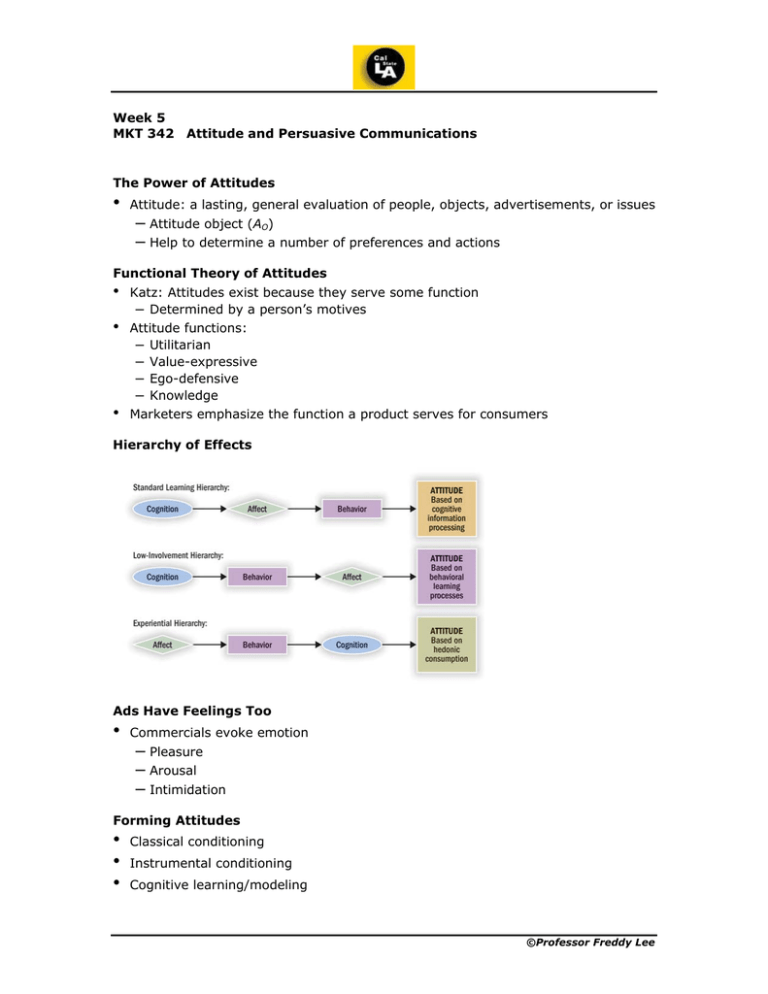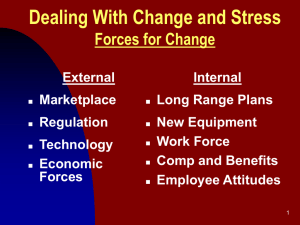
Week 5
MKT 342 Attitude and Persuasive Communications
The Power of Attitudes
•
Attitude: a lasting, general evaluation of people, objects, advertisements, or issues
– Attitude object (AO)
– Help to determine a number of preferences and actions
Functional Theory of Attitudes
•
Katz: Attitudes exist because they serve some function
– Determined by a person’s motives
•
Attitude functions:
– Utilitarian
– Value-expressive
– Ego-defensive
– Knowledge
•
Marketers emphasize the function a product serves for consumers
Hierarchy of Effects
Ads Have Feelings Too
•
Commercials evoke emotion
– Pleasure
– Arousal
– Intimidation
Forming Attitudes
•
•
•
Classical conditioning
Instrumental conditioning
Cognitive learning/modeling
©Professor Freddy Lee
Attitude Commitment
•
Degree of commitment is related to level of involvement with attitude object
– Compliance
– Identification
– Internalization
Cognitive Dissonance & Harmony
•
Conflict of attitudes and behavior motivates us to reduce dissonance
– We make them fit by eliminating, adding, or changing elements
– Explains why evaluations of products increase after purchase
• Horse race experiment
• Marketers: post-purchase reinforcement
Self-Perception Theory
•
We use observations of our own behavior to determine what our attitudes are
– We must have a positive attitude toward a product if we freely purchase it, right?
– Low-involvement hierarchy
– Foot-in-the-door technique
– Low-ball technique
– Door-in-the-face technique
Social Judgment Theory
•
We assimilate new information about attitude objects in light of what we already
know/feel
– Initial attitude = frame of reference
– Latitudes of acceptance and rejection
• Assimilation and contrast effects
• “Choosy mothers choose Jif peanut butter”
Balance Theory
•
Triad attitude structures
– Person
– Perception of attitude object
– Perception of other person/object
• Perception can be positive or negative
•
Balanced/harmonious triad elements
– Unit relation and sentiment relation
Trying to Consume
•
Theory of trying
– Criterion should be trying to reach goal
– Intervening factors between intent and performance
– Several new components to account for act of trying
©Professor Freddy Lee
Theory of Trying
Tracking Attitudes over Time
•
Attitude-tracking program
– More like a “movie” than a “snapshot” of attitudes
– Ongoing tracking studies
• Gallup Poll or Yankelovich Monitor
– Changes to look for…
• Changes in different age groups
• Scenarios about the future
• Identification of change agents
Changing Attitudes
•
Persuasion: effectiveness of marketing communications to change attitudes
– Reciprocity
– Scarcity
– Authority
– Consistency
– Liking
– Consensus
Communication Model
©Professor Freddy Lee
Updated Communications Model
• Consumers are now proactive in communications process
– VCRs, DVRs, video-on-demand, pay-per-view TV, Caller ID, Internet
Building Credibility
•
Relevant qualifications of source to the product can enhance credibility of message
Source Biases
•
Consumer beliefs about product can be weakened by a source perceived to be biased
– Knowledge bias
– Reporting bias (“hired gun”)
Hype vs. Buzz
•
Corporate paradox
Hype
Advertising
Overt
Corporate
Fake
Skepticism
Buzz
Word-of-mouth
Covert
Grass-roots
Authentic
Credibility
©Professor Freddy Lee
Source Attractiveness
•
Perceived social value of source
– Physical appearance
– Personality
– Social status
– Similarity
“What Is Beautiful
Is Good”
•
Halo effect
– Good-looking people are thought to be smarter, cooler, and happier
– Consistency principle
•
Physically attractive source leads to attitude change
– Directs attention to marketing stimuli (ads with attractive models)
– Beauty = source of information (especially for attractiveness- relevant products)
Nonhuman Endorsers
•
•
Often, celebrities’ motives are suspect as endorsers of mismatched products
Thus, marketers seek alternative endorsers:
– Cartoon characters
– Mascots/animals
– Avatars
Dual Component of Brand Attitudes
Two-Factor Theory
•
Repetition can be a double-edged sword…
– Mere exposure phenomenon vs. habituation
©Professor Freddy Lee
Comparative Advertising
•
Message compares two+ recognizable brands on specific attributes
– “New OcuClear relieves three times longer than Visine”
•
•
But…confrontational approach can result in source derogation
Effective for a new product that:
– Does not merely say it is better than leading brand
– Does not compare itself to an obviously superior competitor
Emotional vs. Rational Appeals
•
•
Appeal to the head or to the heart?
Many companies use an emotional strategy when consumers do not find differences
among brands
– Especially brands in well-established, mature categories (e.g., cars and greeting
cards)
•
Recall of ad contents tends to be better for “thinking” ads
– Although conventional ad effectiveness measures may not be entirely valid to
assess emotional ads…
Sex Appeals
•
•
The prevalence of sexual appeals varies from country to country
•
Erotic ad content draws attention, but strong sexual ad imagery may make
consumers less likely to:
– Buy a product (unless product is related to sex)
– Process and recall ad’s content
Nudity/undressed models in print ads generates negative feelings/tension among
same-sex consumers
Humorous Appeals
•
•
Specific cultures have different senses of humor
Overall, humorous ads do get attention
– Funny ad as source of distraction
– Inhibits counterarguing, thus increasing message acceptance
•
Humor is more effective when it:
– Doesn’t “swamp” message of clearly defined brand
– Doesn’t make fun of potential consumer
– Is appropriate to product’s image
©Professor Freddy Lee
Fear Appeals
•
Emphasize negative consequences that can occur unless consumer changes
behavior/ attitude
•
•
Fear is common in advertising (especially in social marketing)
•
Not all threats are equally effective at inducing a fear response
– The strongest threats are not always the most persuasive
Most effective:
– Moderate threat
– Presented solution to problem
– Highly credible source
Message as Art Form
•
Marketers as storytellers (allegory)
– Using literary devices to communicate product benefits/meanings
•
•
•
Metaphor (“A is B”)
Similie (“A is like B”)
Resonance: play on words with picture
– Pepsi ad: “This year, hit the beach topless” with a Pepsi bottle cap lying on the
sand (see Table 8.3 for full list of examples)
ELM
• Receiver will follow one of two routes to persuasion
©Professor Freddy Lee









